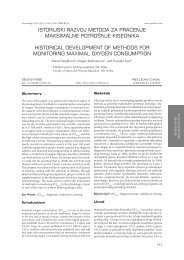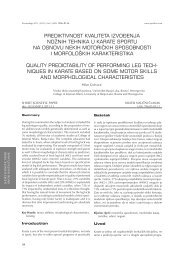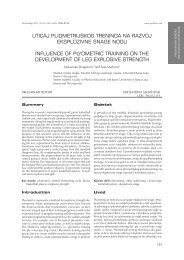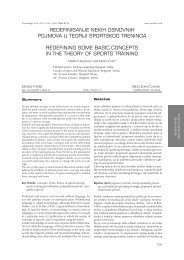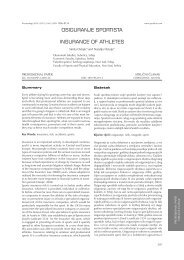specifiÄnosti strukture treninga kod sportista sa oÅ¡teÄenim vidom ...
specifiÄnosti strukture treninga kod sportista sa oÅ¡teÄenim vidom ...
specifiÄnosti strukture treninga kod sportista sa oÅ¡teÄenim vidom ...
Create successful ePaper yourself
Turn your PDF publications into a flip-book with our unique Google optimized e-Paper software.
Ćosić, M. i Koprivica, V.: SPECIFIČNOSTI STRUKTURE TRENINGA... Zbornik radova 2010, 284-296<br />
of characteristics that should be kept in mind when planning<br />
and programming training.<br />
Analysis of available<br />
theoretical papers that<br />
deal with this subject<br />
Already with the first step of examining the papers dealing<br />
with this subject we encounter problems. There are a number<br />
of papers that explore individual problems related to the<br />
topic of this paper, or for sports training and its structure, some<br />
motor skills through which to highlight the differences between<br />
blind and sighted athletes, the visually impaired of all ages,<br />
etc., but the problem is that a very small number of papers<br />
includes a number of areas, or combinations of these themes,<br />
in particular the problems of training of blind athletes. In the<br />
available reference literature, there is no theoretical work on<br />
the structure of training of persons with impaired vision, so<br />
this paper is practically a pioneer in this field in this region.<br />
Analysis of results of testing<br />
people with visual impairments<br />
specifičnosti koje treba imati u vidu kada se planira i programira<br />
trening.<br />
Analiza do<strong>sa</strong>da{njih<br />
teorijskih radova koji<br />
se bave ovom problematikom<br />
Već na prvom koraku pri pregledu radova koji se bave ovom<br />
problematikom nailazi se na probleme. Postoji određeni broj<br />
radova koji istražuju pojedinačno probleme vezane temu<br />
rada, odnosno za sportski trening i njegovu strukturu, pojedine<br />
motoričke sposobnosti preko kojih bi se ukazalo na<br />
razlike između slepih i videćih <strong>sportista</strong>, osobe o{tećenog<br />
vida različitih uzrasta, itd. ali problem je {to vrlo mali broj<br />
radova obuhvata veći broj oblasti, odnosno kombinacije<br />
pomenutih tema, konkretno probleme treniranja slepih<br />
<strong>sportista</strong>. U dostupnoj literaturi nema teorijskih radova o<br />
strukturi <strong>treninga</strong> osoba o{tećenog vida, tako da je ovaj rad<br />
praktično pionirski u ovoj oblasti na ovim prostorima.<br />
Analiza rezultata testiranja<br />
osoba <strong>sa</strong> o{tećenim <strong>vidom</strong><br />
As with theoretical, the situation is similar and with research<br />
papers, that is, there are no papers that integrate several<br />
subjects. However, problems that have been established in<br />
these studies allow better identification of reasons for the<br />
specific training of blind people.<br />
One of the abilities in which blind people are behind the<br />
sighted people is a balance, so there will be a special emphasis<br />
on works that deal with this ability. In these papers it<br />
was concluded that physical training improves the efficient<br />
use of somatosensory, visual and vestibular information,<br />
which improves the ability to maintain balance (Bringoux et<br />
al., 2000), and also different types of sports in various ways<br />
contribute to postural changes (Davlin, 2004). Specific features<br />
of the sports branch make progress in these specific<br />
skills, but not in some skills of daily life (Asseman et al., 2004;<br />
Hugel et al., 1999). Also, athletes (football players) who are<br />
competing at a higher level are more successful in maintaining<br />
of balance (Paillard et al., 2006). The general conclusion,<br />
as far as balance, and as confirmed by a large number of<br />
research, would be that sporting has a positive effect on<br />
static and dynamic balance (Davlin, 2004), and therefore<br />
has a positive impact on sports performance.<br />
In papers on the topic of study cognitive abilities of the blind,<br />
in the age when they should start with sports training, delays<br />
in development was noted (Jablan, 2007). Spatial cognition<br />
research has shown that blind people gain knowledge about<br />
the spatial surroundings with more difficulty and slower than<br />
persons with vision (Jablan, 2007).<br />
In regards to research of the motor space of people with visual<br />
impairments, we can <strong>sa</strong>y that in younger populations blind<br />
are lagging behind in physical development and have less<br />
developed all physical abilities. Because of hypokinesia, specific<br />
movements and postures, which are unique to this<br />
population, many deformities are formed. They also have<br />
delayed motor development. Motor development of children<br />
in young school age is associated with a sports talent (Ćosić,<br />
2003), which is an important condition for further sports development.<br />
Reviewing the norms of motor development, we<br />
can state slowness in the development of mobility and locomotion<br />
of blind children compared with sighted children (Hill, &<br />
Blasch, 1987). It was determined that the overall performance<br />
Kao i <strong>sa</strong> teorijskim radovima, slična je situacija i <strong>sa</strong> istraživačkim<br />
radovima, odnosno nema radova koji objedinjuju vi{e tema.<br />
Međutim, problemi koji su ustanovljeni u ovim istraživanjima<br />
ipak omogućavaju da se na bolji način ukaže na razloge<br />
specifičnosti <strong>treninga</strong> slepih osoba.<br />
Jedna od sposobnosti u kojima slepi zaostaju je ravnoteža,<br />
pa će poseban osvrt biti na radove koji se bave tom sposobno{ću.<br />
U tim radovima se zaključuje da sportski trening utiče na<br />
efikasnije kori{ćenje somatosenzornih, vizuelnih i vestibulativnih<br />
informacija, {to pobolj{ava sposobnost održavanja<br />
ravnoteže (Bringoux i <strong>sa</strong>radnici, 2000) a takođe, različiti<br />
vidovi bavljenje sportom na različite načine doprinose posturalnim<br />
promenama (Davlin, 2004). Specifičnosti određene<br />
sportske grane donose napredak u tim specifičnim sposobnostima,<br />
ali ne i u nekim iz sva<strong>kod</strong>nevnog života (Asseman<br />
i <strong>sa</strong>radnici, 2004; Hugel i <strong>sa</strong>radnici, 1999). Takođe, sportisti<br />
(fudbaleri) koji se takmiče na vi{em nivou imaju veću<br />
uspe{nost održavanja ravnoteže (Paillard i <strong>sa</strong>radnici, 2006).<br />
Generalni zaključak, {to se ravnoteže tiče, a {to i veliki broj<br />
istraživanja i potvrđuje, bio bi da bavljenje sportom pozitivno<br />
utiče na statičku i dinamičku ravnotežu (Davlin, 2004),<br />
a da <strong>sa</strong>mim tim ima i pozitivan uticaj na sportski rezultat.<br />
U radovima <strong>sa</strong> temom proučavanja kognitivnih sposobnosti<br />
slepih, u uzrastu kada treba da se počne <strong>sa</strong> sportskim<br />
treningom, evidentirano je zaostajanje u razvoju (Jablan,<br />
2007). Istraživanja spacijalne kognicije pokazuju da slepe<br />
osobe stiču znanja o prostoru teže i sporije u odnosu na<br />
osobe <strong>sa</strong> <strong>vidom</strong> (Jablan, 2007).<br />
[to se tiče istraživanja motoričkog prostora osoba <strong>sa</strong> o{tećenim<br />
<strong>vidom</strong> možemo reći da <strong>kod</strong> mlađe populacije slepi zaostaju<br />
u telesnom razvoju i da imaju slabije razvijene sve fizičke<br />
sposobnosti. Zbog hipokinezije i specifičnih pokreta, kretanja<br />
i stavova, koji su jedinstveni za ovu populaciju, nastaju<br />
i brojni telesni deformiteti. Oni takođe imaju i usporen<br />
razvoj motorike. Motorički razvoj <strong>kod</strong> dece mlađeg {kolskog<br />
uzrasta veoma je povezan <strong>sa</strong> sportskom obdareno{ću (Ćosić,<br />
2003), koja je bitan uslov za dalji sportski razvoj. Pregledom<br />
normi motoričkog razvoja možemo konstatovati usporenost<br />
u razvoju pokretljivosti i lokomocije slepe dece u<br />
poređenju <strong>sa</strong> decom koja vide (Hill i Blasch, 1987). Utvrđeno<br />
PROFESSIONAL PAPER<br />
STRUČNI ČLANAK<br />
287



